Gabon: Sette Cama Surprises
 Anselm, Patrice and Stephane untangled nets and later Stephane and I added floats (old empty soda bottles… a different kind of recycling!)
Anselm, Patrice and Stephane untangled nets and later Stephane and I added floats (old empty soda bottles… a different kind of recycling!) Tom scans a cove where manatees are often seen feeding. We did see a group of three that day, just off the point of trees in front of Tom. You can see the aquatic plants (dark against the sand) under the water.
Tom scans a cove where manatees are often seen feeding. We did see a group of three that day, just off the point of trees in front of Tom. You can see the aquatic plants (dark against the sand) under the water.
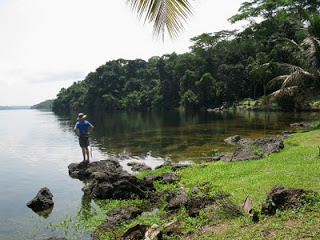 Uzoma holding one of the aquatic plants, Crinum natans, a manatee favorite. These are tiny ones, they grow to be the size of a leek.
Uzoma holding one of the aquatic plants, Crinum natans, a manatee favorite. These are tiny ones, they grow to be the size of a leek. I had a good team of 6 others with me: Stephane (Gabonese manatee researcher), Uzoma (Nigerian manatee researcher), Ken (WCS veterinarian who has previously worked with manatees in the USA), Patrice (Gabonese veterinarian), Anselm (WWF biologist) and Tom (a photographer from Save Our Seas Foundation, who funded the telemetry equipment, the boat engine and some of the other logistics). We began setting nets for manatees on the 5th. For the first 8 days of setting nets around the clock in 6 different locations (we had 2-4 nets going at once) we did not catch any manatees, despite seeing manatees in close proximity to nets everyday and setting in the same locations used by former hunters. Unfortunately some of the nets were old (they had been confiscated from hunters) and the manatees (or in some cases possibly crocs) broke through at night, leaving large holes for us to find most mornings, a very unpleasant surprise. So we were more than a bit frustrated and very tired.
I had a good team of 6 others with me: Stephane (Gabonese manatee researcher), Uzoma (Nigerian manatee researcher), Ken (WCS veterinarian who has previously worked with manatees in the USA), Patrice (Gabonese veterinarian), Anselm (WWF biologist) and Tom (a photographer from Save Our Seas Foundation, who funded the telemetry equipment, the boat engine and some of the other logistics). We began setting nets for manatees on the 5th. For the first 8 days of setting nets around the clock in 6 different locations (we had 2-4 nets going at once) we did not catch any manatees, despite seeing manatees in close proximity to nets everyday and setting in the same locations used by former hunters. Unfortunately some of the nets were old (they had been confiscated from hunters) and the manatees (or in some cases possibly crocs) broke through at night, leaving large holes for us to find most mornings, a very unpleasant surprise. So we were more than a bit frustrated and very tired.Anselm casts net into the water during a set at the open cove with the aquatic plants…
 Uzoma sets net at one of our mangrove sites…
Uzoma sets net at one of our mangrove sites…
 …and we also set nets along grassy areas where manatees feed. As you might guess, we spent alot of time setting nets, checking nets and re-setting nets. Also second guessing where the manatees would turn up (the answer is, at almost every site, but not in the nets!)
…and we also set nets along grassy areas where manatees feed. As you might guess, we spent alot of time setting nets, checking nets and re-setting nets. Also second guessing where the manatees would turn up (the answer is, at almost every site, but not in the nets!)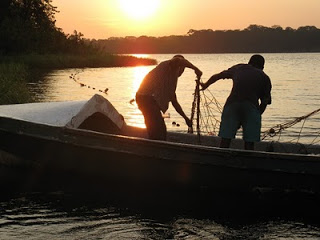 Tags were ready to go in the boat in case we caught a manatee. Here we also had the GPS unit and some mangrove samples in theucket.
Tags were ready to go in the boat in case we caught a manatee. Here we also had the GPS unit and some mangrove samples in theucket.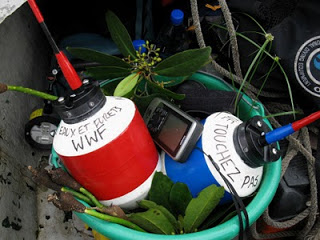 Patice and Uzo waiting in the boat in case a manatee is captured. On this day they had manatees socializing next to the boat and nets for over an hour, but none got caught!
Patice and Uzo waiting in the boat in case a manatee is captured. On this day they had manatees socializing next to the boat and nets for over an hour, but none got caught!
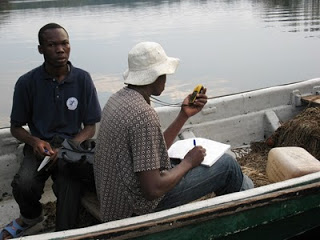 Waiting, waiting and more waiting… Simplice (Gabonese ecoguide who came out with us one day), Anselm and Stephane watch from the mangroves.
Waiting, waiting and more waiting… Simplice (Gabonese ecoguide who came out with us one day), Anselm and Stephane watch from the mangroves.
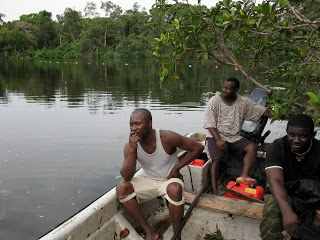 Some people passed the time dozing, while others played with their cameras (Ken & Tom). We all fought the tsetse flies!
Some people passed the time dozing, while others played with their cameras (Ken & Tom). We all fought the tsetse flies!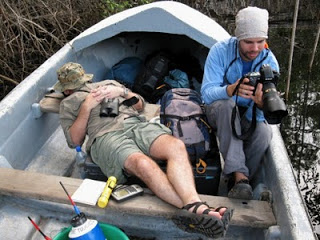 Anselm displays a large hole in a net made overnight
Anselm displays a large hole in a net made overnight 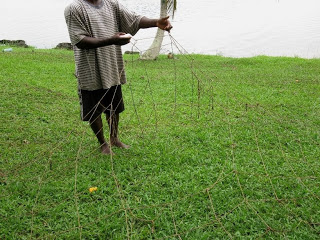
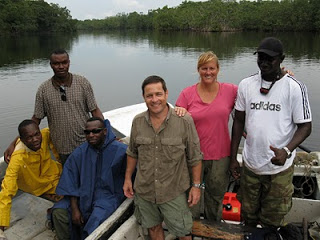 I gave the team an A for effort, and could not help but share their disappointment. We all fell into bed exhausted everyday and nothing seemed easy. Patrice and Uzoma had to depart on 10 and 11 December, so we were left with 5 people after that. But then on the 9th (and last) day………
I gave the team an A for effort, and could not help but share their disappointment. We all fell into bed exhausted everyday and nothing seemed easy. Patrice and Uzoma had to depart on 10 and 11 December, so we were left with 5 people after that. But then on the 9th (and last) day………

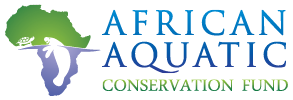

Pamela Thye
January 15, 2010 at 9:20 amLucy, so glad you got ONE. I remember you explaining in Libreville how difficult it was to see them, much less net them unlike here in Florida's Indian River Lagoon, Vero Beach, where we are at the moment. Poor things are freezing their whiskers off right now. We've had 27 degrees these past night and arond 32 for 10 days. Have not heard from Buddy how things are on his side. Gulls and pelicans are enjoying a bounty of dead fish – the latter look like over stuffed baked potatoes.
Lucy
January 15, 2010 at 4:36 pmThanks Pamela, and you are correct, we were lucky to get any at all! I've been part of capture efforts in Costa Rica where nothing was caught and the same happenerd in Panama. We'll keep trying here in the future.
Enjoy your time in FL, I actually miss the cold weather! It's always so steamy hot here. Cheers, Lucy